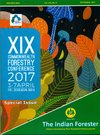Abundance Trends in Papilionid Butterflies over a Decade: Implications and Conservation Lessons for Butterflies in Kerala, India
DOI:
https://doi.org/10.36808/if/2017/v143i9/118903Keywords:
Papilionidae, Abundance, Weather, Correlation, India.Abstract
Changes in abundance of butterfly species across temporal scales is an area in ecological research which has hardly been investigated in the Indian context. In this study, we have attempted to analyse the butterfly count data recorded at the Kerala Forest Research Institute, Peechi, India. Correlations between the weather parameters and the butterfly abundance were sought and the species relation to these variables were analysed. Correlation between the species and weather variables in the first round of sampling was tested against the second round of sampling conducted after a gap of ten years. Finally, linear regression was performed to ascertain the relationship between the variables. The results of this study indicate that identifying patterns of change in the abundance of butterfly species in response to abiotic factors is crucial to understanding the complex nature of butterfly communities.References
Anto M. and Mathew G. (2014). Butterflies and Forest Management in the Western Ghats- the indicator approach. In: Forest Entomology: Emerging Issues and Dimensions. (Mujeeb R.P. and M. Anto, Eds.), Narendra Publishing House, New Delhi. 189-201pp.
Dennis R.L.H. and Sparks T.H. (2007). Climate signals are reflected in an 89 year series of British Lepidoptera records. European J. Entomology, 104: 763–767.
Forister M.L., McCall A.C., Sanders N.J., Fordyce J.A., Thorne J.H., O'Brien J., Waetjen D.P. and Shapiro A.M. (2010). Compounded effects of climate change and habitat alteration shift patterns of butterfly diversity. PNAS, 107 (5): 2088-2092.
Hill J.K., Thomas C.D. and Huntley B. (2003). Modelling present and potential future ranges of European butterflies using climate response surfaces. In: Butterflies: ecology and evolution taking flight. (C.L. Boggs, W.B. Watt and P.R. Ehrlich, Eds.), Chicago, University of Chicago Press, 149–167pp.
Jaworski T. and Hilszczanski J. (2013). The effect of temperature and humidity changes on insects development and their impact on forest ecosystems in the context of expected climate change. Lesne Prace Badawcze (Forest Research Papers), 74 (4):345-355.
Kwon T.S., Kim S.S., Chun J.H., Byun B.K., Lin J.H. and Shin J.H. (2010). Changes in butterfly abundance in response to global warming and reforestation. Environmental Entomology, 39 : 337-345.
Mathew G. and Anto M. (2007). In situ conservation of butterflies through establishment of butterfly gardens: a case study at Peechi, Kerala, India. Current Science, 93 (3): 337-347.
Oliver T.H., Marshall H.H., Morecroft M.D., Brereton T., Prudhomme C. and Huntingford C. (2015). Interacting effects of climate change and habitat fragmentation on drought-sensitive butterflies. Nature Climate Change, 5: 941–945.
Parmesan C., Phyholm N., Stefanescus C., Hill J.K., Thomas C.D., Descimon H., Huntley B., Kalla L., Kullberg J. and Tammaru T. (1999). Poleward shifts in geographic ranges of butterfly species associated with regional warming. Nature, 399: 579–583.
Pollard E. and Yates T.J. (1993). Monitoring butterflies for ecology and conservation. The British butterfly monitoring scheme. Institute of Terrestrial Ecology and Joint Nature Conservation Committee. Chapman and Hall, London. 274 pp.
Roy D.B. and Sparks T.H. (2000). Phenology of British butterflies and climate change. Global Change Biology, 6: 407–416.
Roy D.B., Rothery P., Moss D., Pollard E. and Thomas J.A. (2001). Butterfly numbers and weather: predicting historical trends in abundance and the future effects of climate change. J. Animal Ecology, 70: 201-217.
Scheffers B.R., Edwards D.P., Diesmos A., Williams S.E. and Evans T.A. (2014). Microhabitats reduce animals' exposure to climate extremes. Global Change Biology, 20: 495-503.
Sparrow H.R., Thomas D.S., Ehrlich P.R. and Murphy D.D. (1994). Techniques and guidelines for monitoring neotropical butterflies. Conservation Biology, 8(3): 800–809.
Spitzer K., Jaros J., Havelka J. and Leps J. (1997). Effect of small-scale disturbance on butterfly communities of an Indochinese montane rainforest. Biological Conservation, 80 (1): 9-15.
Warren M.S., Hill J.K., Thomas J.A., Asher J., Fox R., Huntley B., Roy D.B., Telfer S., Jeffcoate M.G. and Harding P. (2014). Rapid responses of British butterflies to opposing forces of climate and habitat change. Nature, 414: 65-69.
Weiss S.B., Murphy D.D. and White R.R. (1988). Sun, slope, and butterflies: topographic determinants of habitat quality for Euphydryas editha. Ecology, 69(5) 1486-1496.
Zografou K., Kati V., Grill A., Wilson R.J., Tzirkalli E., Pamperis L.N. and Halley J.M. (2014). Signals of climate change in butterfly communities in a Mediterranean protected area. PloS ONE, 9(1): e87245.
Downloads
Downloads
Published
How to Cite
Issue
Section
License
Unless otherwise stated, copyright or similar rights in all materials presented on the site, including graphical images, are owned by Indian Forester.





